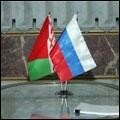Другие материалы рубрики «English»
-
 Russia seeking $1.5 billion from Minsk
Russia seeking $1.5 billion from Minsk
Moscow has suggested that Belarus transfer $1.5 billion more to the Russian budget over its reported move to export diesel fuel made of Russian crude under the guise of solvents, diluents and lubricants... -
 Opposition activists remember Stalinist terror victims
Opposition activists remember Stalinist terror victims
Some 200 opposition activists took part in an annual commemorative march staged in Minsk on Sunday to honor the memory of the victims of the Stalinist terror on the occasion of Dzyady...
- Memorial to Polish soldiers vanishes from Stalin-era massacre site
- IMF representative warns that high GDP growth rate would jeopardize macroeconomic stability
- Delegation of Belarus’ Liberal Democratic Party meets with Duma members in Moscow
- Belarus is strongly opposed to any sanctions, foreign minister says
- Lukashenka meets with Russian foreign minister
- Opposition activists commemorate victims of Bolshevik terror at Kurapaty
- Vendors at Homyel shopping center stage one-day walkout to protest rent rise
- Relatives, colleagues pay tribute to murdered journalist Charkasava
- Coach denies that national soccer team was motivated by Lukashenka's criticism
- Expert on creation of city brand for Minsk
English
Belarus exported conventional arms to Azerbaijan, Uganda, Sudan in 2009, report says
Belarus exported conventional arms to Azerbaijan, Uganda and Sudan in 2009, says the country’s report that has been posted on the site of the UN Register of Conventional Arms, BelaPAN reports.
In particular, according to the report filed on May 20, last year Belarus exported 23 T-55 battle tanks to Uganda, nine 2C7 Pion 203-milimeter self-propelled guns to Azerbaijan, five Russian Sukhoi Su-25 Frogfoot ground attack aircraft to Azerbaijan, and three Su-25 planes to Sudan. The value of the contracts was not disclosed.
 The report says that Belarus did not import any conventional arms in 2009.
The report says that Belarus did not import any conventional arms in 2009.
In 2008, Belarus reportedly did not import any conventional arms either and exported three 2C7 Pion guns to Azerbaijan, 33 MiG-23 swing-wing fighter aircraft to Syria, 11 Su-25 planes to Sudan, and 15 R-27R medium-range air-to-air tactical missiles to Russia.
In 2007, Belarus supplied two upgraded BTR-70 armored personnel carriers to Sudan, 10 122-milimeter D-30 howitzer guns to Armenia, and nine Uragan multiple launch rocket systems to Eritrea.
In 2006, Belarus sold 41 T-72 battle tanks to Azerbaijan in its only arms trade deal that year.
In 2005, Belarus supplied Azerbaijan with 19 T-72 tanks, exported two Mi-8 helicopters to Slovakia and two Mi-24 choppers to Djibouti.
In 2004, Belarus supplied Sudan with 21 BRDM-2 armored reconnaissance vehicles, seven BTR-80 and 10 BTR-70 armored personnel carriers and a BMP-1 infantry fighting vehicle. In addition, Belarus sold two Su-25 planes to Cote d’Ivoire.
In 2003, Belarus exported nine BMP-2 infantry fighting vehicles, 39 BRDM-2s and 32 artillery systems to Sudan, 19 missiles for the Igla mobile anti-aircraft system to Sweden and 20 armored vehicles and 16 artillery systems to Cote d’Ivoire.
Between 1996 and 2002, Belarus sold arms to Iran, Algeria, Sudan, Cote d’Ivoire, Peru, Congo, Papua New Guinea, Sierra Leone, Ethiopia, Uganda, Morocco, the United Arab Emirates and Ukraine.
Each year, all UN member states, together with observers such as Switzerland, are asked to report to the UN their imports and exports of major conventional weapons during the previous year. Information is requested on transfers of seven categories of such weapons: main battle tanks; armored combat vehicles; large caliber artillery systems (over 100 mm); combat aircraft; attack helicopters; warships (above 750 tons); and missiles and missile launchers (range above 25 km).
For each category, states are requested to provide the numbers of weapons that they have imported or exported for each country of origin or destination, using a standardized reporting form. They are also invited, on a voluntary basis, to provide further qualitative information on these transfers, such as the types and models of weapons involved and the purposes of the transfer. Participating States are similarly invited by the UN to provide “available background information” on their national procurement and military holdings.
Information on transfers during the previous calendar year is supposed to be sent to the UN by the end of May. In September or October each year, these reports are compiled and published as an annual report from the UN Secretary-General.



В настоящее время комментариев к этому материалу нет.
Вы можете стать первым, разместив свой комментарий в форме слева